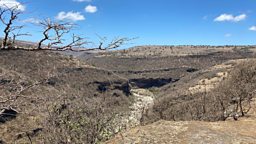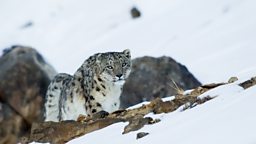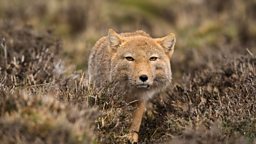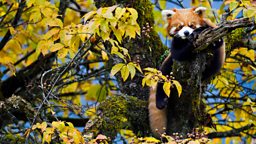Saving Oman’s unique desert cloud forest
By Sara Douglas, Producer / Director
...the backbone of one of Asia’s most remarkable and unexpected ecosystems...
In the far south of Oman, the Dhofar Mountains rise dramatically from the desert plains, forming the backbone of one of Asia’s most remarkable and unexpected ecosystems: the desert cloud forest. These mountains are crucial to the existence of the forest, acting as a barrier that captures moisture-laden clouds from the Indian Ocean during the monsoon season, known locally as the Khareef. For just a few months each year, these clouds blanket the mountains, transforming the arid landscape into a lush, green sanctuary.
By trapping moisture, the mountains enable a diverse array of plant and animal life to thrive in a region that would otherwise be too dry. The trees that grow here, nourished by this seasonal influx of water, are essential for the human communities and wildlife that depend on this ecosystem.
However, this delicate natural cycle is under threat. The forest faces many challenges but the most notable are over-grazing, climate change and deforestation. Over the past few decades, Dhofar’s cloud forest has lost approximately 70% of its original tree cover.
Without urgent action, the mountains’ ability to capture moisture and sustain the forest could be diminished, putting the entire region at risk. In response, a major reforestation project has been devised.
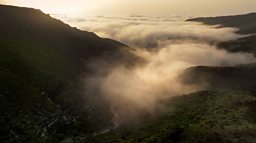
The Importance of Dhofar’s Cloud Forest
...it’s about ensuring long-term water supplies and maintaining a delicate environmental balance.
It could be easy to overlook this bizarre and stunted forest, but its significance is far-reaching. More than 90% of the region’s groundwater is the result of these trees. In a desert climate where water is the most precious resource, the forest is vital to local water security. These trees capture moisture from the air during the monsoon and store it, allowing water to trickle slowly into the groundwater reserves. The slow release of water is crucial for sustaining life in this dry landscape.
Without these trees, water shortages would become more severe, impacting both humans and wildlife. Therefore, saving the forest is about more than preserving trees—it’s about ensuring long-term water supplies and maintaining a delicate environmental balance.
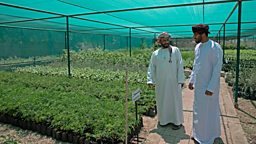
A Reforestation Project Takes Root
...the project is helping create a greener future for the entire country.
In 2020, a large-scale reforestation project was launched in Dhofar to protect and restore the cloud forest. This ambitious initiative is a collaboration between SERC (Social and Environmental Reforestation Collaboration) and the MECA (Ministry of Environment and Climate Affairs) and focuses on restoring tree cover and improving the resilience of the ecosystem.
So far, five nurseries have been established across the region to cultivate native tree species. These nurseries have already produced over 150,000 trees, representing 28 different species.
Seeds are collected from the remaining forest, then cleaned and prepared for planting. Later, they’re carefully grown in controlled environments. The resulting young trees are planted back in degraded areas of the forest, where they are given a chance to re-establish themselves.
But this project goes beyond Dhofar. As part of a national effort to increase reforestation, some of the trees from the nurseries are sent to other parts of Oman that do not have this initiative. In doing so, the project is helping create a greener future for the entire country.
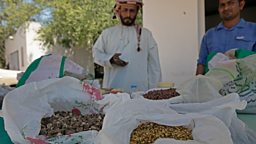
Threats and challenges
...shifting climate patterns threaten to reduce the reliability of these seasonal rains...
While the project has seen significant success, threats remain.
Overgrazing is a particularly tricky issue, as camels hold significant cultural and economic value in Oman. For generations, camels have been central to the livelihoods of many local communities in Dhofar. However, large numbers of camels cause considerable damage to the fragile ecosystem. Young saplings planted in the reforestation efforts are particularly vulnerable to being grazed.
To mitigate this issue, the government has stepped in to support the local camel herders. One of the solutions proposed is to compensate people by providing feed for their camels.
Climate change could present another threat. If temperatures rise and rainfall becomes more erratic, the health of the forest and its ability to regenerate will be placed under increasing pressure. While the Khareef has long provided the moisture necessary for the cloud forest to thrive, shifting climate patterns threaten to reduce the reliability of these seasonal rains, leading to drier conditions and slower tree growth.
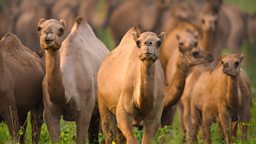
Why the desert cloud forest matters for the world
...vital in the global fight against climate instability.
Though it may seem like a relatively small and isolated part of the world, Oman's desert cloud forest is a critical ecosystem with global significance. Desert forests, especially those watered by clouds, are rare and vulnerable to climate change. Their ability to lock up carbon and regulate local water cycles makes them vital in the global fight against climate instability.
Moreover, these forests are home to a wide diversity of species, some of which are found nowhere else in the world. By protecting this unique ecosystem, Oman is also preserving the biodiversity that has adapted to this extraordinary environment over millennia.
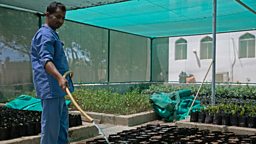
Looking to the Future
Education is also key.
The future of Oman's cloud forest hangs in the balance. While the reforestation project has made significant strides, much work remains to be done.
With overgrazing, climate change, and deforestation still major threats, ongoing collaboration between local communities, the government, and conservation organisations will be crucial to the forest’s survival.
Education is also key. By raising awareness of the forest’s importance and engaging people in the conservation process, the project can ensure that future generations take pride in protecting this remarkable natural resource.


